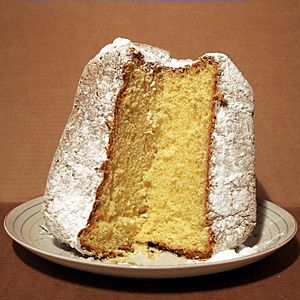Pandoro facts for kids

Pandoro
|
|
| Type | Dessert bread |
|---|---|
| Place of origin | Italy |
| Region or state | Veneto (Verona) |
| Main ingredients | Flour, eggs, butter and sugar |
Pandoro is a yummy, traditional Italian sweet bread. It is most popular around Christmas and New Year celebrations. This special bread comes from Verona, a city in Italy.
Pandoro has a unique shape, like a tall, eight-pointed star. People often dust it with vanilla-scented icing sugar. This makes it look like the snowy peaks of the Italian Alps during winter.
History of Pandoro
The name Pandoro means 'golden bread'. This sweet bread has a very old history, going back to ancient times. Long ago, white bread was only for rich people. Most people ate dark bread, or sometimes no bread at all. Sweet breads, like Pandoro, were special treats for kings and queens.
Breads made with eggs, butter, and sugar or honey were served in palaces. These were known as 'royal bread' or 'golden bread'. Even in ancient Rome, people enjoyed a similar bread. The writer Pliny the Elder described it in the 1st century. It was made with fine flour, eggs, butter, and oil.
The first clear mention of a dessert called Pandoro was in the 18th century. It was a favorite among the rich people of Venice. Venice was a big trading center for spices and sugar. Sugar had replaced honey in many European sweets by then.
The recipe for modern Pandoro was perfected in Verona, which was part of Venetian territory. It took about a hundred years to get it just right! The Pandoro we know today began on October 30, 1894. That's when Domenico Melegatti got a patent for making Pandoro in factories.
See also
 In Spanish: Pandoro para niños
In Spanish: Pandoro para niños


